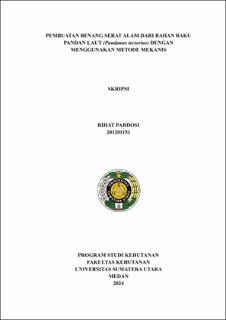Pembuatan Benang Serat Alam dari Bahan Baku Pandan Laut (Pandanus tectorius) dengan Menggunakan Metode Mekanis
Raw Material of Yarn Made of Natural Fiber of Sea Pandan (Pandanus tectorius) using Mechanical Method

Date
2024Author
Pardosi, Rihat
Advisor(s)
Risnasari, Iwan
Nuryawan, Arif
Metadata
Show full item recordAbstract
Pandan laut (Pandanus tectorius) is a type of monocot plant that reaches 6 meters
in height. Sea pandan leaves have various uses in various fields, both in cooking,
the pharmaceutical industry and the cosmetics industry. However, there are other
benefits of sea pandan leaves that are still little investigated, namely the use of sea
pandan leaf fibers into natural fiber yarn. In this research, natural fiber yarn will
be made from sea pandan leaves. In general, threads made from natural fibers have
almost the same properties, namely strong, dense, easy to tangle and resistant to
ironing. The method for separating sea pandan leaf fibers used in this research was
using an iron comb. Testing the quality of sea pandan natural fiber yarn was
consisted of physical properties, namely water content and specific gravity of sea
pandan fiber and testing mechanical properties, namely maximum tensile strength
(stress), strain and Young's modulus. Test results for fresh sea pandan water content
ranged from 16.3-19.8% with an average of 17.7%. Meanwhile, the water content
of dried sea pandan ranges from 9.89 to 12.36 with an average of 11.33. The test
results for the specific gravity of dried sea pandan fiber ranged from 1.48 to 3.65
with an average of 2.74, while the specific gravity of fresh sea pandx an fiber
ranged from 0.49 to 3.26 with an average of 1.59. For the tensile test, there were 2
treatments, namely 3 strands and 5 strands. The average sequential tensile stress
test results of 3 strands of fresh pandan, 3 strands of dry, 5 strands of fresh, and 5
strands of dry pandan were 5.06 N, 7.23 N, 6.06 N, and 8.73 N. The average
sequential strain test results are 0.031%, 0.030%, 0.032%, and 0.035%. The
average sequential Young's modulus test results are 171.07 Mpa, 286.51 Mpa,
216.26 Mpa, and 289.68 Mpa
Collections
- Undergraduate Theses [2167]
